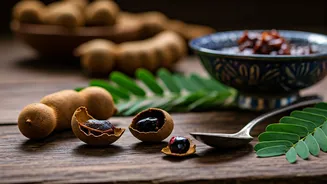Tamarind: An Overview
Tamarind, scientifically known as *Tamarindus indica*, is a tropical tree producing edible, pod-like fruits highly prized in various cuisines worldwide.
Native to Africa, it has become integral to Indian, Southeast Asian, and Latin American cooking, providing a complex flavor profile that ranges from sweet to sour, and often with a hint of earthy notes. The pods contain a sticky pulp surrounding dark brown seeds. This pulp is the edible part, and it is rich in tartaric acid, which gives tamarind its characteristic sourness. Its versatility makes it suitable for both sweet and savory applications, from candies and chutneys to curries and beverages, offering both flavor and natural preservation qualities. The tamarind's unique taste is crucial for balancing flavors in dishes, providing depth and a refreshing tang. Proper selection involves choosing pods that feel firm, with no cracks or visible mold. The preparation methods depend on usage, either directly for certain dishes or processed to extract the pulp.
Sourcing and Selection
The journey of cooking with tamarind starts with selecting the right tamarind pods. When buying, look for pods that appear plump and firm to the touch, indicating freshness and sufficient pulp content. Avoid pods that feel dry or have visible cracks, as these may indicate lower quality or age. The color can vary, but generally, darker pods tend to have a richer, more intense flavor. Consider the source, too. Locally sourced tamarind pods often offer the best freshness and flavor profile, reflecting the specific climate and soil conditions. Check the label or ask the vendor to get an idea of the tamarind’s origin. The availability of tamarind might vary based on the season and region, and it's best to buy during its peak season for the best quality. Ensure the pods are free from any signs of mold, which can indicate that the tamarind has been improperly stored or has gone bad. Good quality tamarind will have a pleasant, slightly sweet and tangy aroma, which is a good indicator of its flavor.
Preparing Tamarind Pulp
Extracting the tamarind pulp is a fundamental step in using it in your cooking. Start by removing the outer shell and any fibers from the tamarind pods. This reveals the sticky, pulpy interior that contains the seeds. The easiest method is to soak the tamarind in hot water for about 15-20 minutes. This softens the pulp and makes it easier to extract. The ratio of water to tamarind depends on the desired consistency. For a thicker pulp, use less water; for a thinner, more liquid base, use more water. After soaking, use your fingers or a spoon to work the pulp, separating it from the seeds. You can also press the tamarind through a sieve or strainer to remove any remaining fibers and seeds. The resulting pulp is the foundation for various recipes. The extracted pulp's concentration can be adjusted by adding more or less water. The resulting tamarind pulp can then be used fresh or stored for future use. It can be refrigerated for a short time or frozen for longer preservation.
Tamarind in Curries
Tamarind is a key ingredient in many South Indian curries, imparting its characteristic sour and tangy notes. It's often used in dishes like sambar and rasam. The tamarind pulp provides a necessary balance to the richness of the spices and other ingredients, such as vegetables and lentils. Its acidity cuts through the richness, creating a harmonious and balanced flavor profile. In preparing a curry with tamarind, the pulp is typically added during the cooking process. It can be added directly to the curry as it simmers, allowing the flavors to meld. The quantity of tamarind used varies according to personal taste and the dish itself. Start with a small amount and adjust it as needed. The sourness enhances the flavors of other ingredients like turmeric, coriander, and chili, making it an essential component of many traditional recipes. Tamarind also acts as a natural tenderizer for meats and helps to break down fibrous vegetables, enhancing the overall texture of the dish.
Tamarind in Beverages
Tamarind adds a distinct tang to beverages, creating refreshing and flavorful drinks. It’s used in various preparations across different cultures. In India, tamarind water, also known as imli pani, is a common refreshment, especially during the hot summer months. It's often sweetened with sugar or jaggery. The sourness of tamarind combines with sweetness to give a balanced drink that’s both invigorating and hydrating. Tamarind can also be used to make tamarind juice. This beverage is a popular choice during festivals and celebrations. To prepare, dilute tamarind pulp with water, add a sweetener of choice, and serve chilled. In some parts of Southeast Asia and Latin America, tamarind is used to make cocktails. The unique sourness provides a refreshing twist to classic drinks. Adding tamarind to beverages not only enhances the flavor profile but also offers potential health benefits due to its nutritional content, including antioxidants.
Tamarind in Sauces
Tamarind transforms sauces by introducing a unique balance of sweet and sour notes. It is a common element in sauces across Asia. Tamarind paste provides a tangy base for various dishes. In many Thai dishes, tamarind is a fundamental element in Pad Thai, providing the crucial sour element that balances the dish's other flavors. The tamarind pulp is often mixed with fish sauce, palm sugar, and chili to create a complex sauce. In Indian cuisine, tamarind is a key ingredient in chutneys. It is usually combined with other ingredients like dates, spices, and chilies to create sweet, tangy, and sometimes spicy condiments. The tamarind's natural acidity also acts as a natural preservative, increasing the shelf life of these sauces. Adding tamarind can offer a depth of flavor that is difficult to replicate with other ingredients, creating complex and balanced sauces that enhance a variety of dishes.
Sweet Treats with Tamarind
Tamarind can be a surprising ingredient in many sweet treats, providing a tangy contrast to sweetness. It pairs well with various flavors. In some regions, tamarind candies are a popular snack, where tamarind pulp is sweetened and often mixed with spices. These candies offer a delicious balance of sweet, sour, and sometimes spicy flavors. Tamarind is also sometimes used in jams and preserves, particularly in tropical regions. The sourness of tamarind adds complexity to the sweetness of the fruit, creating a more sophisticated flavor profile. In baking, tamarind can be incorporated into cakes and pastries. It can be used to add a unique twist to classic desserts. Tamarind can be combined with chocolate to create a complex and exciting flavor experience. The sourness and tanginess of tamarind make it an exciting ingredient in the world of desserts, offering a pleasant surprise for the taste buds and an interesting contrast to the sweetness.















